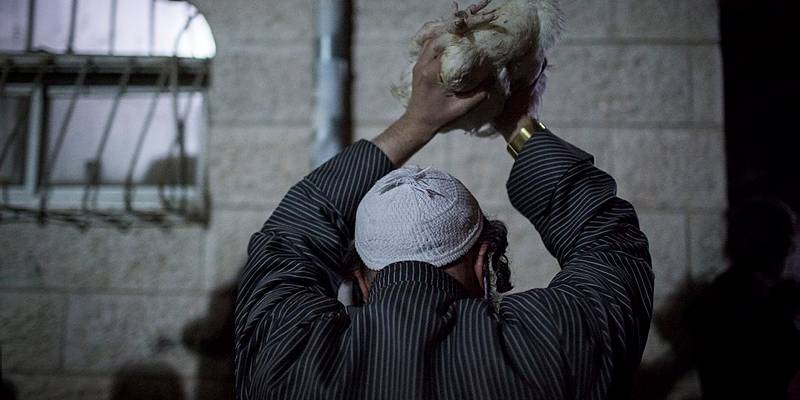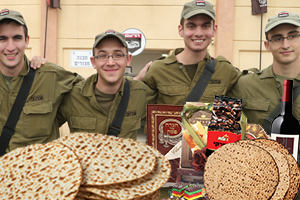Using money instead of a chicken to perform Kapparot – a pre-Yom Kippur atonement ritual – is a more attractive, cleaner and less expensive option.
By Rabbi Ari Enkin, Rabbinic Director, United with Israel
While kapparot , the customary atonement ritual practiced on the eve of Yom Kippur, often by using a live chicken, may appear to the onlooker as some sort of bizarre tribal incantation, its origins are quite interesting.
As the practice is not mentioned anywhere in the Talmud nor in early legal codes, there have been authorities throughout the ages who have tried to ban the practice – but to no avail.
Indeed, Ashkenazi practice is to view kapparot as a minhag vatikin – a venerated practice that one must not neglect. Indeed, we are even taught to use a separate chicken for each and every family member.
It is clear that Rashi himself used to perform kapparot, although not with a chicken – he used flowers.
Some have explained the practice of kapparot as being modeled after the idea of offering a Temple sacrifice.
The Rambam explains this idea, suggesting that in the event that we deserve death due to our many sins, God in His mercy allows us to substitute an animal for slaughter rather than ourselves.
Indeed, while performing the ritual, we should contemplate the fragility of life and our gratitude at having our own extended. The chicken should then be donated to the poor for Holy Day consumption.

A poster reading “Kaparot revenues,” encouraging people to donate money to the poor, posted in Beitar Illit, an ultra-orthodox community in the Judean Mountains. (Nati Shohat/Flash90)
Originally, kapparot was performed any time right before Rosh Hashana through to the end of Sukkot. However, over the centuries the custom has evolved to reserve this ritual for Erev Yom Kippur.
The question must be asked: Why do we use a chicken? Why not use a larger animal more symbolic of sacrifices and of ourselves? Indeed, some suggest using a ram for kapparot in memory of the near sacrifice of the patriarch Isaac on the altar and to recall the ram that was substituted in his place. Since, however, many people were poor and could not afford such an expensive animal, they made do with a chicken.
It should also be noted that the Talmudic term for a chicken is gever, which can also translate as “man,” thus affirming a chicken as entirely fitting for the ritual.
What about pregnant women? Should they use one, two, or even three chickens? Some authorities suggest that a pregnant woman use three chickens – one for herself, a chicken in case the child is a female and a rooster in case it is a male. Another approach found in the code of law is for a pregnant woman to use two birds – one chicken and one rooster.
This way, if the fetus is a female, then the mother and daughter are included together in the chicken. If the fetus is a male, then the rooster will have been of use.
In addition to the chicken option for kapparot, money is an attractive, clean and less expensive option for performing kapparot. Swinging money around one’s head while reciting the kapparot formula and then donating the money to charity is a legitimate alternative. Fish is sometimes used for kapparot as well, often seen as a compromise between chicken and money.
In ancient times, there was considerable opposition to kapparot for a number of reasons. For starters, the procedure somewhat resembles ancient practices of witchcraft and black magic, from which we are required to distance ourselves. Another reason was due to the tremendous pressure placed on the shochtim (ritual slaughterers). It was argued that it was simply not possible for the shochtim to properly slaughter the large number of chickens and still make it home with enough time to personally prepare for Yom Kippur. Such pressure could easily lead to improperly slaughtered chickens. In deference to this credible concern, one should consider performing kapparot som time before Yom Kippur if intending to use a live chicken.
While kapparot is a topic that invites more depth and study, let us conclude by focusing on its primary purpose – namely, to bring a person’s heart closer to God during this holy period. Remember, it’s not kapparot that will purge us of our sins. Rather, what is important is to change our behavior – specifically repentance, prayer, and charity.

Send Passover Packages to Needy Israeli Soldiers - Bring Them Joy!
We are honored to thank the young men and women of the IDF who risk their lives every day to protect the citizens of Israel. Since October 7th, soldiers have been on the battlefield for months - many are hoping to come home for Passover.
Join us in sending Passover food packages (and personal notes) to Israeli soldiers and their families.
Many soldiers spend the Passover holiday with needy families back home. The soldiers greatly appreciate your love and concern. Bring them Passover joy!
CLICK HERE TO SEND YOUR PACKAGE AND NOTE TO ISRAELI SOLDIERS!




